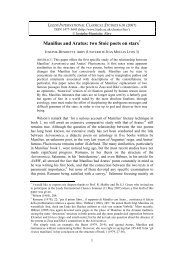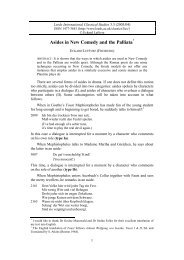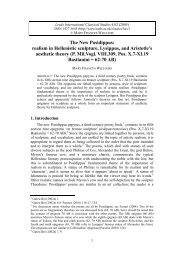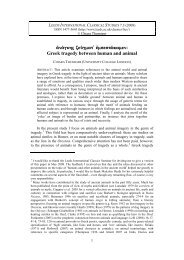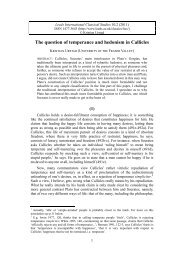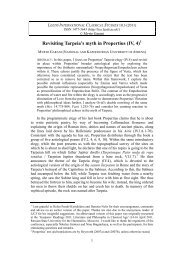Metalepsis, paragraphe and the scholia to Hermogenes - Leeds ...
Metalepsis, paragraphe and the scholia to Hermogenes - Leeds ...
Metalepsis, paragraphe and the scholia to Hermogenes - Leeds ...
Create successful ePaper yourself
Turn your PDF publications into a flip-book with our unique Google optimized e-Paper software.
MALCOLM HEATH, METALEPSIS, PARAGRAPHE AND THE SCHOLIA TO HERMOGENES<br />
holds that <strong>the</strong> issue of <strong>the</strong> prior question in documentary metalepsis is always<br />
legal; so he rejects (192.2-18) <strong>Hermogenes</strong>’ statement (80.1) that it is sometimes<br />
definition. He does not explain how <strong>the</strong> insistence that <strong>the</strong> prior question is legal<br />
is <strong>to</strong> be reconciled with his classification of Against Timarchus as <strong>paragraphe</strong>.<br />
Nor does he explain a unique feature of Against Timarchus—<strong>the</strong> fact that <strong>the</strong> first<br />
question, about <strong>the</strong> admissibility of <strong>the</strong> primary case, is not followed by a second<br />
question about <strong>the</strong> primary case itself (191.26-31); he merely refers us vaguely <strong>to</strong><br />
‘<strong>the</strong> interpreter’ of Aeschines’ speech for an explanation (see fur<strong>the</strong>r §1.9). It is<br />
worth noting that his comments on Against Timarchus assume that both questions<br />
would normally be argued out in a single hearing (a question raised in §1.4<br />
above). If <strong>the</strong> absence of <strong>the</strong> second question in Against Timarchus is unique, <strong>the</strong>n<br />
<strong>the</strong> normal expectation must be that <strong>the</strong> second question will be treated within <strong>the</strong><br />
same speech as <strong>the</strong> <strong>paragraphe</strong>. Moreover, since this expectation apparently<br />
applies even in a case (such as that against Timarchus) in which <strong>paragraphe</strong> is<br />
successful, <strong>the</strong> assumption must be that <strong>the</strong>re is normally a single verdict at <strong>the</strong><br />
end of <strong>the</strong> single hearing. 38<br />
<strong>Hermogenes</strong>’ view on <strong>the</strong> issue of <strong>the</strong> prior question is also rejected, though in<br />
a different way, by Eustathius. He is cited (Nilus fol. 156v; Chris<strong>to</strong>phorus fol.<br />
131r) 39 for <strong>the</strong> view that <strong>paragraphe</strong> may be based on conjecture, definition, letter<br />
<strong>and</strong> intent, or ambiguity. This is similar <strong>to</strong> <strong>the</strong> view mentioned under Aquila<br />
(§1.6), except that ambiguity takes <strong>the</strong> place of conflict of law. This variance is<br />
perhaps related <strong>to</strong> <strong>the</strong> reinterpretation of <strong>the</strong> prior question in <strong>Hermogenes</strong>’<br />
example of documentary metalepsis as ambiguity ra<strong>the</strong>r than letter <strong>and</strong> intent,<br />
which we observed in Sopater’s commentary. But it is puzzling: what, for<br />
example, would Eustathius do with <strong>the</strong> conflict of law in <strong>the</strong> example from<br />
Sopater’s Division of Questions (§1.7)?<br />
Sopater describes <strong>paragraphe</strong> as a ‘complete ejection’ (kbol¾ ... tele…a) of<br />
<strong>the</strong> primary case (191.5-26, cf. 110.14f.). This implies that he underst<strong>and</strong>s<br />
‘complete <strong>paragraphe</strong>’ <strong>to</strong> be making a contrast with non-documentary metalepsis;<br />
<strong>the</strong>re is no indication that he distinguished complete <strong>and</strong> incomplete <strong>paragraphe</strong><br />
within <strong>the</strong> documentary species. So <strong>the</strong> problem which troubled Athanasius would<br />
not arise for him. Marcellinus, one of <strong>the</strong> main sources of <strong>the</strong> ‘three-man<br />
commentary’ (RG 4), 40 also takes up <strong>the</strong> question of what <strong>Hermogenes</strong> meant<br />
when he described documentary metalepsis as a ‘complete <strong>paragraphe</strong>’ (292.18-<br />
29). He rejects <strong>the</strong> view that documentary metalepsis is being contrasted with <strong>the</strong><br />
incomplete non-documentary metalepsis; instead he contrasts complete<br />
<strong>paragraphe</strong>, which rejects <strong>the</strong> primary case completely, with incomplete<br />
but does not endorse it (RG 4.285.28-286.9, 782.2-8). Compare <strong>the</strong> head of homonymy in<br />
Marcomannus’ division of <strong>paragraphe</strong> (340.31-7).<br />
38 Of course, a successful incomplete <strong>paragraphe</strong> leaves open <strong>the</strong> possibility that <strong>the</strong> prosecution<br />
will be renewed under o<strong>the</strong>r circumstances. But this is irrelevant <strong>to</strong> Sopater’s point: in this sense,<br />
<strong>the</strong> second question (that is, primary case against Aeschines) was heard, with Demos<strong>the</strong>nes as<br />
prosecu<strong>to</strong>r.<br />
39 Gloeckner (1901) 79; Rabe (1895) 248: see Appendix 7. Fur<strong>the</strong>r fragments from unpublished<br />
<strong>scholia</strong> are collected in Gloeckner (1901) 78-86, (1908) 22-5; Schilling (1903) 715-33.<br />
40 The text of <strong>the</strong> ‘three-man commentary’ is given in Appendix 4.<br />
14



